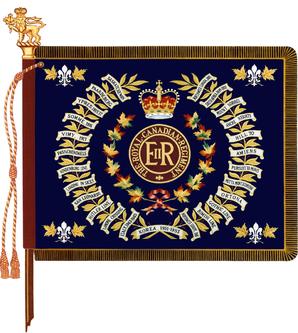Royal Canadian Regiment facts for kids
Quick facts for kids Royal Canadian Regiment |
|
|---|---|
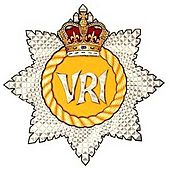
|
|
| Active | 21 December 1883 – present |
| Country | Canada |
| Branch | Canadian Army |
| Type | Line Infantry |
| Role | Mechanized infantry (two battalions) light role/paratroop (one battalion) light role/primary reserve (one battalion) |
| Size | Four battalions |
| Part of | Royal Canadian Infantry Corps |
| Garrison/HQ | RHQ – Petawawa 1st Battalion – Petawawa 2nd Battalion – Gagetown 3rd Battalion – Petawawa 4th Battalion – London |
| Nickname(s) | formally Royal Canadians, informally Junior Royals |
| Motto(s) | Latin: Pro patria, lit. 'For country' |
| March | Quick – "The Royal Canadian Regiment" (aka "St. Catharines") Slow – "Pro Patria" |
| Anniversaries | Regimental birthday – 21 December Paardeberg Day – 27 February Pachino Day – 10 July Mons Day – 10 November Kowang-san Day – 23 October |
| Engagements | Fenian Raids North-West Rebellion Second Boer War First World War Second World War Korean War War in Afghanistan |
| Decorations | Commander-in-Chief Unit Commendation – 1st Battalion: Afghanistan, Operation ARCHER, 2006. |
| Battle honours | See #Battle honours |
| Commanders | |
| Colonel-in-Chief | Vacant |
| Colonel of The Regiment | MGen Denis W. Thompson |
| Patrons | Judith Irving, Mike Holmes |
| Notable commanders |
William Dillon Otter |
| Insignia | |
| Tartan | Maple Leaf (2nd Bn pipes and drums) |
| Abbreviation | The RCR |
The Royal Canadian Regiment (RCR) is an infantry regiment of the Canadian Army. It is one of Canada's oldest military units. The RCR has four battalions, which are like groups of soldiers. Three of these battalions are part of the regular army, and one is a reserve unit. The RCR is ranked first among Canadian Army infantry regiments.
The RCR started as the Infantry School Corps on December 21, 1883. Its first three companies were in Fredericton, New Brunswick; St Jean, Quebec; and Toronto, Ontario. A fourth company was added in 1887 in London, Ontario. Today, the regiment's four battalions are in Ontario and New Brunswick. Many of its soldiers come from Ontario and the Atlantic Provinces. This makes the RCR a "local" infantry regiment for English-speaking eastern Canada.
The RCR has a Regimental Headquarters (RHQ) in Petawawa, Ontario. This office handles regimental matters that are not part of the individual battalions' daily duties. The Royal Canadian Regiment Museum is in Wolseley Hall in London, Ontario. Wolseley Barracks in London has been used by the regiment since 1888. It has been home to the Regimental Headquarters, the 1st and 2nd Battalions, and is still home to the 4th Battalion today.
Contents
- Meet the RCR Battalions
- How the RCR Was Formed
- Regimental Connections and Alliances
- Battle Honours: A History of Courage
- History of the Royal Canadian Regiment
- Public Recognition
- Important Leaders and Supporters
- The RCR Cap Badge
- Company Names
- Regimental Bands
- Regimental Music
- See also
- Order of precedence
- Images for kids
Meet the RCR Battalions
The Royal Canadian Regiment is made up of four main groups called battalions. Each battalion has a special role and is based in a different location.
| Battalion | Home Base | Brigade | What They Do |
|---|---|---|---|
| 1st Battalion, The Royal Canadian Regiment | CFB Petawawa (Ontario) | 2 Canadian Mechanized Brigade Group | They are Mechanized infantry, meaning they use vehicles to move and fight. |
| 2nd Battalion, The Royal Canadian Regiment | CFB Gagetown (New Brunswick) | 2 Canadian Mechanized Brigade Group | They are also mechanized infantry, using vehicles for combat. |
| 3rd Battalion, The Royal Canadian Regiment | CFB Petawawa (Ontario) | 2 Canadian Mechanized Brigade Group | They are Light infantry, meaning they move mostly on foot. They also have a parachute company. |
| 4th Battalion, The Royal Canadian Regiment | Wolseley Barracks and Stratford Garrison (Ontario) | 31 Canadian Brigade Group | They are light infantry and a Reserve unit. This means they are part-time soldiers. |
How the RCR Was Formed
This section shows the history of the Royal Canadian Regiment and how it changed over time.
The Royal Canadian Regiment's History
- Started on December 21, 1883, as the Infantry School Corps.
- Renamed the Canadian Regiment of Infantry on May 14, 1892.
- Renamed the Royal Regiment of Canadian Infantry on May 24, 1893.
- Renamed the Royal Canadian Regiment of Infantry on April 1, 1899.
- Renamed The Royal Canadian Regiment on November 1, 1901.
- On April 25, 1958, it joined with The London and Oxford Fusiliers (3rd Battalion, The Royal Canadian Regiment) and kept its name.
- The 3rd Battalion, The Royal Canadian Regiment (London and Oxford Fusiliers) was renamed the 4th Battalion, The Royal Canadian Regiment (London and Oxford Fusiliers) in 1970.
- The 4th Battalion, The Royal Canadian Regiment (London and Oxford Fusiliers) was renamed the 4th Battalion, The Royal Canadian Regiment on May 22, 1990.
The London and Oxford Fusiliers (3rd Battalion, The Royal Canadian Regiment)
- Started on April 27, 1866, in London, Ontario, as the 7th Battalion Infantry, "Prince Arthur's Own."
- Renamed the 7th Battalion Infantry on May 1, 1866.
- Renamed the 7th Battalion "London Light Infantry" on February 15, 1867.
- Renamed the 7th Battalion "Fusiliers" on January 16, 1880.
- Renamed the 7th Regiment "Fusiliers" on May 8, 1900.
- Renamed The Western Ontario Regiment on March 29, 1920.
- Renamed The Canadian Fusiliers (City of London Regiment) on August 1, 1924.
- On December 15, 1936, it joined with parts of the 2nd Machine Gun Battalion, CMGC, and was renamed The Canadian Fusiliers (City of London Regiment) (Machine Gun).
- Renamed the 2nd (Reserve) Battalion, The Canadian Fusiliers (City of London Regiment) on January 29, 1942.
- Renamed the 2nd (Reserve) Battalion, The Canadian Fusiliers (City of London Regiment) (Machine Gun) on March 24, 1942.
- Renamed The Canadian Fusiliers (City of London Regiment) (Machine Gun) on April 1, 1946.
- On October 1, 1954, it joined with The Oxford Rifles and was renamed the London and Oxford Fusiliers (3rd Battalion, The Royal Canadian Regiment).
- On April 25, 1958, it joined with The Royal Canadian Regiment and was renamed the 3rd Battalion, The Royal Canadian Regiment (London and Oxford Fusiliers).
The Oxford Rifles
- Started on August 14, 1863, in Woodstock, Ontario, as the Twenty-second Battalion Volunteer Militia Rifles, Canada or The Oxford Rifles.
- Renamed the 22nd Battalion The Oxford Rifles on April 13, 1866.
- Renamed the 22nd Regiment The Oxford Rifles on May 8, 1900.
- Renamed the Oxford Rifles on March 29, 1920.
- Renamed the 2nd (Reserve) Battalion, The Oxford Rifles on March 18, 1942.
- Renamed The Oxford Rifles on June 1, 1945.
- On October 1, 1954, it joined with The Canadian Fusiliers (City of London Regiment) (Machine Gun) and was renamed the London and Oxford Fusiliers (3rd Battalion, The Royal Canadian Regiment).
The 2nd Machine Gun Battalion, CMGC
- Started on June 1, 1919, in London, Ontario, as the 2nd Machine Gun Brigade, CMGC.
- Renamed the 2nd Machine Gun Battalion, CMGC on September 15, 1924.
- Joined with The Canadian Fusiliers (City of London Regiment) on December 15, 1936.
Regimental Connections and Alliances
The RCR has special connections to older military units and alliances with other regiments around the world.
Units the RCR Remembers
The RCR "perpetuates" or remembers the history of several older military units.
War of 1812 Units
- The Loyal London Volunteers
- 1st Regiment of Middlesex Militia
- 1st Regiment of Oxford Militia
First World War Units
- 1st Battalion (Ontario Regiment), CEF
- 33rd Battalion, CEF
- 71st Battalion, CEF
- 142nd Battalion (London's Own), CEF
- 168th Battalion (Oxfords), CEF
- 2nd Battalion, Canadian Machine Gun Corps, CEF
Friends Around the World: Alliances
The RCR has special friendships with these regiments from other countries:
 United Kingdom – The Royal Regiment of Fusiliers (United Kingdom)
United Kingdom – The Royal Regiment of Fusiliers (United Kingdom) United Kingdom – The Rifles (United Kingdom)
United Kingdom – The Rifles (United Kingdom) Jamaica – The Jamaica Regiment (Jamaica)
Jamaica – The Jamaica Regiment (Jamaica)
Battle Honours: A History of Courage
Battle honours are special awards given to military units for their bravery in battles and campaigns. The Royal Canadian Regiment has earned 61 battle honours. Honours in capital letters are for large operations, while those in lowercase are for specific battles. The ones in bold are proudly displayed on the regiment's flags.
War of 1812 Honours
- Defence of Canada – 1812–1815
- Detroit
- Niagara
- A special honour for Defence of Canada – 1812–1815 (not on flags).
North West Rebellion Honours
- Saskatchewan
- North West Canada, 1885
South African War Honours
- Paardeberg
- South Africa, 1899–1900
First World War Honours
- Ypres, 1915, '17
- Gravenstafel
- St. Julien
- Festubert, 1915
- Mount Sorrel
- Somme, 1916
- Pozières
- Flers–Courcelette
- Ancre Heights
- Arras, 1917, '18
- Vimy, 1917
- Arleux
- Scarpe, 1917, '18
- Hill 70
- Passchendaele
- Amiens
- Drocourt–Quéant
- Hindenburg Line
- Canal du Nord
- Cambrai, 1918
- Pursuit to Mons
- France and Flanders, 1915–18
Second World War Honours
- Landing in Sicily
- Valguarnera
- Agira
- Adrano
- Regalbuto
- Sicily, 1943
- Landing at Reggio
- Motta Montecorvino
- Campobasso
- Torella
- San Leonardo
- The Gully
- Ortona
- Cassino II
- Gustav Line
- Liri Valley
- Hitler Line
- Gothic Line
- Lamone Crossing
- Misano Ridge
- Rimini Line
- San Martino–San Lorenzo
- Pisciatello
- Fosso Vecchio
- Italy, 1943–1945
- Apeldoorn
- North-West Europe, 1945
Korean War Honours
Afghanistan Honours
- Afghanistan
History of the Royal Canadian Regiment
The RCR has a long and proud history, taking part in many important events for Canada.
Early Days of the RCR
The Royal Canadian Regiment is one of Canada's oldest regular army units. In 2012, the regiment was linked to units from the War of 1812. This means they carry three battle honours from that conflict.
The regiment started as the Infantry School Corps on December 21, 1883. These "school corps" were regular units created to train the Canadian militia. The first companies were set up in Fredericton, St Jean-sur-Richelieu, and Toronto in 1883. A fourth company was added in London, Ontario, a few years later.
The Infantry School Corps earned its first battle honours during the North-West Rebellion in 1885. They fought in battles like Batoche and Cut Knife Creek. The regiment also sent soldiers to the Yukon Field Force (1898–1900). These soldiers helped the North-West Mounted Police in the Yukon during the Gold Rush. The regiment served in the South African (Boer) War from 1899 to 1903. Their deployment to the First World War was delayed because they were stationed in Bermuda from September 1914 to August 1915. After returning to Nova Scotia, they joined the Canadian Expeditionary Force (CEF) and arrived in France in October 1915 to fight in WW1.
The South African War (Boer War)
The regiment's name changed to The Royal Canadian Regiment of Infantry in 1893. This showed a new focus on being ready for combat. William Dillon Otter was the first Commanding Officer. He later became the first Canadian-born head of the Canadian Army.
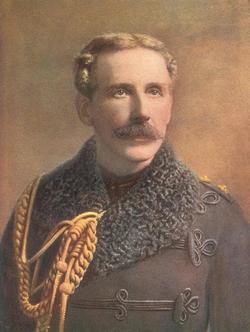
During the South African War (Second Boer War), a special "2nd (Special Service) Battalion" was formed. It included soldiers from all over Canada and was led by Otter. This battalion was quickly disbanded in 1900 when they returned to Canada. Many British officers thought they were the best infantry battalion in the country. A "3rd (Special Service) Battalion" was also formed in 1900. It served as a garrison force in Halifax until 1902, when it was also disbanded.
In the Boer War, the Toronto company of the 2RCRI fought Canada's first overseas battle. This happened at Sunnyside, Cape Colony, on January 1, 1900. They defeated a Boer commando group. The whole unit then played a key role in the victory at the Battle of Paardeberg Drift (February 18–27, 1900). They advanced at night and dug trenches very close to the Boer lines. On February 27, 1900, the Boers surrendered. This opened the way to Bloemfontein, the first Boer capital. This day is now celebrated by the Regiment as Paardeberg Day. The Regiment was the first to arrive at the gates of Pretoria.
During the South African War, Private Richard Rowland Thompson received a Queen's scarf. Only four were given to soldiers from the Dominions.
From Victorian Era to the First World War: 1900–1919
In October 1901, the regiment received new colours (flags) from the Duke of Cornwall and York, who later became King George V. The regiment's name was changed to The Royal Canadian Regiment. In 1914, the regiment was sent to Bermuda for garrison duties. They stayed there from September 1914 to August 1915. Then they returned to Halifax and prepared for overseas service. The RCR arrived in France in October 1915 to join the new 3rd Canadian Division. The regiment joined with Princess Patricia's Canadian Light Infantry and other battalions to form the 7th Canadian Infantry Brigade.
Many battle honours were given to The Royal Canadian Regiment for its actions in the First World War. These included "Mount Sorrel," "Somme, 1916," "Vimy, 1917," "Hill 70," "Ypres, 1917," "Passchendaele," and "Amiens."
Among the awards given to members of the regiment in the First World War was the Victoria Cross (VC). This was won by Lieutenant Milton Gregg. The RCR also recognizes the VC won by Lieutenant Frederick William Campbell. He was an officer of a battalion that is now remembered by The RCR.
Between the World Wars: 1919–1939
The RCR remained a permanent force regiment between the wars. They went back to training the Militia. They were stationed in London (Ontario), Halifax (Nova Scotia), Toronto (Ontario), and Montreal (Quebec).
The Second World War: 1939–1945
On September 1, 1939, the regiment was called to active duty as Canada prepared for the Second World War. By September 10, when war was declared, the RCR was already part of the 1st Canadian Infantry Brigade. This brigade was made up entirely of units from Ontario. The RCR moved to the United Kingdom in December 1939. They trained hard for almost four years as part of the 1st Canadian Infantry Division.
On July 10, 1943, the RCR landed at Pachino during the start of the Allied invasion of Sicily. The regiment and its sister units fought in several battles as they moved north and east towards Messina. After the 38-day campaign on the island, the regiment was involved in another amphibious landing. This was called Operation Baytown at Reggio di Calabria, Italy, in September.
The RCR fought in many battles during the Italian campaign. This included key fights in the Moro River valley near Ortona in December 1943. In 1944, the regiment took part in the Battle of Monte Cassino. They attacked German defensive lines called the Hitler Line and later the Gothic Line.
In February 1945, the regiment moved to northwest Europe during Operation Goldflake. They helped liberate the Dutch city of Apeldoorn. The regiment received 28 battle honours for its part in the Second World War. The regiment returned home to Canada in 1945.
After the Wars: The Korean War and Cold War
Korean War: 1945–1953
In 1950, the regiment was asked to send soldiers to the Korean War. The regiment grew to have two, then three, battalions. The 2nd Battalion, followed by the 1st and 3rd Battalions, all served in Korea. The 2nd Battalion helped keep the peace at the 38th parallel. In October 1952, the 1st Battalion fought the Chinese at the battle of Kowang-san (Hill 355). The 3rd Battalion took over the Jamestown Line on Hill 187. They fought one of the last battles before the armistice in 1953. After the Korean War, the regiment went back to two battalions. The 3rd Battalion was disbanded in July 1954.
The Cold War: 1953–1992
In 1954, two London, Ontario, Militia regiments joined together. They became The London and Oxford Fusiliers (3rd Battalion, The Royal Canadian Regiment). This unit became the Reserve part of The RCR. In 1958, it was renamed 3rd Battalion, The Royal Canadian Regiment (London and Oxford Fusiliers).
In 1989, the Reserve battalion's name was shortened to 4th Battalion, The Royal Canadian Regiment. This joining also meant the regiment remembered more First World War battalions. This increased the total battle honours for the First World War.
The Militia battalion (3rd Battalion) was renumbered as the 4th Battalion in 1970. This happened when the Canadian Guards were reduced in size. Their soldiers became the restored 3rd Battalion, The RCR, in the regular army. At the same time, the 2nd Battalion of The RCR moved to CFB Gagetown, New Brunswick. Its soldiers came from the Black Watch (Royal Highland Regiment) of Canada.
During the 1950s and 1960s, RCR battalions were stationed in Germany. They were part of 4 Canadian Mechanized Brigade Group. These deployments were done by 1RCR (1955–57 and 1962–65) and 2RCR (1953–55 and 1965–70). The 3rd Battalion was later sent to Germany, stationed in Baden-Söllingen from 1977–84 and 1988–93.
All three Regular Force battalions of The RCR were deployed during the October Crisis in 1970. This was part of the government's response to the FLQ. Major John Hasek became the first commander of the Skyhawks Parachute Team when it started in 1971. The three Regular Force battalions also helped support the 1976 Summer Olympics in Montreal, Quebec.
Throughout the Cold War, The RCR helped with Canada's United Nations peacekeeping efforts. This meant battalions of the regiment took turns serving in Cyprus. They completed 13 six-month tours there between 1966 and 1992.
In 1977, the 3rd Battalion was posted to CFB Baden-Soellingen in Germany.
In 1983, a plaque at the Royal Military College Saint-Jean marked 100 years of service for the Royal Canadian Regiment. This is Canada's oldest permanent force infantry regiment.
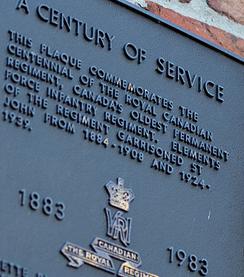
In 1984, the battalion moved to Winnipeg. In 1988, it moved back to Baden until the base closed in 1993. It was then disbanded in Germany and later reformed at CFB Borden, Ontario. This was a "10/90" battalion. This meant about 10% of its soldiers were full-time, and the rest were Reserve Force soldiers. These units existed until 1996. Then, the three 10/90 battalions were replaced by light infantry battalions in the regular army. The light infantry battalion moved to CFB Petawawa and became the 3rd Battalion, The RCR.
In 1990, parts of the 1st Battalion went to Cornwall, Ontario, for Operation Kahnawake. The 2nd Battalion went to the Montreal region for Operation Salon. These were part of the government's response to the Oka Crisis.
In 1991, companies from the 3rd Battalion (Germany) and 1RCR (London, Ontario) served in the Persian Gulf. This was during Operations Desert Shield and Desert Storm, the first Gulf War. These companies provided security for airfields and field hospitals.
Peacekeeping Missions: 1992–2004
In 1992, soldiers from the 3rd Battalion, based in Germany, helped secure the Sarajevo airport. This was during the Yugoslav Wars. This operation involved moving the entire battle group from Croatia to Sarajevo. General Lewis MacKenzie was in command.
Elizabeth II, Queen of Canada, spoke about this mission. She praised the Canadian soldiers for bringing peace to Bosnia.
Later, the Governor General of Canada gave the Commander-in-Chief Unit Commendation to N Company. This was for opening the airport in Sarajevo in July 1992.
The unit returned to Bosnia for a tour with the stabilization force, SFOR, in 1998 and 1999.
All three Regular Force battalions served as peacekeepers in the Sinai Peninsula and in Bosnia. The 1st Battalion served in Kosovo under NATO mission Operation Kinetic from December 1999 to May 2000.
In 2000, the 2nd Battalion had the honour of guarding Buckingham Palace. This was to remember Canada's role in the Second Boer War. Later that year, part of the 2nd Battalion went to eastern Africa as part of UNMEE.
In March 2004, a company went to Port-au-Prince, Haiti, for Operation Halo. They conducted security operations to prepare for the United Nations to take over.
Afghanistan and Beyond: 2003–Present
In August 2003, the 3rd Battalion went to Kabul, Afghanistan, for a six-month tour. The battalion had the first Canadian casualties from enemy action in the war. They also conducted the first Canadian company-level direct action raid against insurgent forces since the Korean War.
In August 2006, the 1st Battalion went to Afghanistan as part of Operation Athena. They replaced another battalion for a six-month tour.
In February 2007, the 2nd Battalion replaced the 1st Battalion in Afghanistan.
In September 2008, the 3rd Battalion replaced another battalion. They formed the core of the Task Force Kanadahar Battle Group. They served until April 2009. The training of a platoon from the battalion was filmed for the TV show Combat School.
In April 2010, the 1st Battalion deployed for Task Force 1–10.
In February 2012, the 2nd Battalion formed the core of a training mission in Afghanistan. They went to Kabul for Operation Attention until November 2012.
In October–November 2018, 82 soldiers from all four battalions and 38 members of the Royal Canadian Artillery Band guarded Buckingham Palace, St James's Palace, the Tower of London, and Windsor Castle.
The RCR has also sent personnel to Canadian Forces Joint Task Force-Ukraine since 2014.
Public Recognition
The Royal Canadian Regiment has received special recognition from cities and Canada Post.
Freedom of the City
The Royal Canadian Regiment was given the Freedom of the City in Fredericton, New Brunswick on June 2, 1973. They also received it in St. John's, Newfoundland and Labrador on June 19, 2005. This honour allows them to march through the city with drums beating and flags flying.
Commemorative Stamps
On November 10, 1983, Canada Post released a stamp featuring 'The Royal Canadian Regiment.' This was part of a series celebrating Canadian Forces regiments.
Important Leaders and Supporters
The RCR has special honorary appointments, which are important roles held by respected individuals.
Colonel-in-Chief
Prince Philip, Duke of Edinburgh, was the colonel-in-chief of the RCR from December 8, 1953, until his death in 2021. He was the second person to hold this role.
Colonel of the Regiment
The Colonel of the Regiment is the most senior person for regimental affairs. They lead the Regimental Council and advise other groups. The current Colonel of the Regiment is former Governor General of Canada David Johnston, who took the role on August 4, 2018.
Honorary Lieutenant-Colonel, 4th Battalion
This person advises and guides the 4th Battalion specifically. The current honorary lieutenant-colonel is Colonel Bruce W. Burnham.
Patrons
On June 5, 2012, Judith Irving became the first patron of the Regiment. In December 2013, Mike Holmes was also appointed a patron.
Regimental Sculptor
On June 26, 2013, Christian Cardell Corbet was named the first Regimental Sculptor. This happened in London, UK, after he unveiled a sculpture of Prince Philip.
The RCR Cap Badge
The RCR cap badge is a special symbol that soldiers wear on their hats.
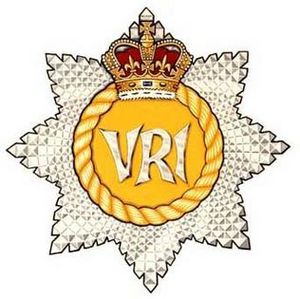 |
|
The letters VRI on the cap badge stand for Victoria Regina Imperatrix. This is Latin for "Victoria, Queen and Empress." Queen Victoria gave the regiment the right to wear her special symbol and crown in 1893.
Usually, a royal symbol on a badge changes with each new king or queen. But in 1919, King George V gave The Royal Canadian Regiment unique permission to keep wearing "VRI" forever.
Company Names
The companies within the RCR battalions are named with letters.
- 1st Battalion – A to F
- 2nd Battalion – G to L
- 3rd Battalion – M to R
- 4th Battalion – S, T and X (S Company has its headquarters and two rifle platoons in London, Ontario, and a third platoon in Stratford, Ontario. T Company has its headquarters in Stratford, and X Company has the battalion headquarters staff.)
In the regular army battalions, the first four companies are "rifle companies" (main fighting units). The last two are for combat support (weapons) and administration.
When on parade, companies line up in alphabetical order. They are usually called by their NATO phonetic alphabet letter. However, there are a few exceptions:
- A Coy, 1RCR, is called "Duke of Edinburgh's Company" or "Duke's Company."
- C Coy, 1RCR, is known as "Charles" Company. This name was given during the Korean War because the company kept a very high standard of dress.
- M Coy, 3RCR, is often called "Para" Company, short for Parachute Company. This is because the 3rd Battalion can do airborne operations.
Regimental Bands
The RCR has different types of bands that add to its traditions.
Bugles and Drums
The first band of The RCR was formed in 1894. Sergeant Charles Hayes, a music college graduate, joined in January 1894. That same year, the corps also trained nine buglers.
The regiment had an active band during much of the First World War. They continued to have a Drum and Bugle band until the 1990s.
Pipes and Drums
In 1970, some infantry battalions were disbanded. Soldiers from the Canadian Guards and the Black Watch (Royal Highland Regiment) of Canada joined The Royal Canadian Regiment. The 2nd Battalion, Royal Canadian Regiment, adopted the Pipes and Drums of the Black Watch. The 3rd Battalion of The RCR adopted the Pipes and Drums of the 2nd Battalion, The Canadian Guards. In 1977, the 3rd Battalion Pipes and Drums were renamed the Special Service Force Pipes and Drums.
Today, the 2nd Battalion The Royal Canadian Regiment has the only Pipes and Drums in the Canadian regular army.
The RCR Band
The "Drum and Bugles" and "Pipes and Drums" bands have members who are also trained infantry soldiers. The RCR Band, however, was a professional brass and reed band with military musicians. This band was formed in London in the 1950s. It moved to CFB Gagetown in the 1970s and was disbanded in the 1990s.
Regimental Music
The RCR has several pieces of music associated with its history.
- "Hurrah for our boys in khaki" by Fred & Chas Adams was published around 1900. It was dedicated to the Royal Canadian Regiment.
- "The Regimental March of the Royal Canadian Regiment" by Lieut. Langford and G. Offen was published in 1910.
- "March, The Royal Canadian Regiment" by Arthur W. Hughes was published around 1900.
See also
- The Canadian Crown and the Canadian Forces
- List of Canadian organizations with royal patronage
- Royal Canadian Regiment Museum
- 3rd Battalion, The Royal Canadian Regiment
- Military history of Canada
- History of the Canadian Army
- Canadian Forces
- Maroon beret
- The Canadian Guards
Order of precedence
Regular Force:
| Preceded by None; first in precedence of infantry regiments |
The Royal Canadian Regiment | Succeeded by Princess Patricia's Canadian Light Infantry |
Reserve Force:
| Preceded by The Lincoln and Welland Regiment |
4th Battalion, The Royal Canadian Regiment | Succeeded by The Royal Highland Fusiliers of Canada |
Images for kids
-
A Major of the 3rd Battalion, RCR on parade in Kyiv, August 2018.


